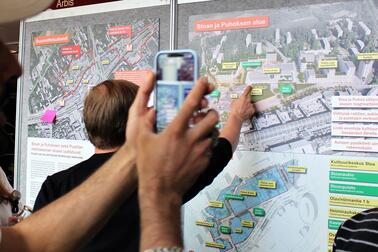
The city regularly monitors health and well-being in its residential areas, both based on its own statistical and research data as well as data from its service system. In the PUHTI project (Information Outside the Service System), researchers have a unique opportunity to utilise new and diverse data sources to gain a broader situational awareness of each areas’ residents—information that can be used to strengthen public health policymaking. The project’s recent report presents results related to purchasing behaviour, payment defaults and children and young people's sports activities and physical functioning capabilities.
Unhealthy grocery purchases and payment defaults are most common in low-income areas
Results related to purchasing behaviour show that tobacco is used less frequently in residential areas with a high socio-economic status than in other areas. Another example are alcohol purchases from grocery stores, which are also less common in areas of high socio-economic status.
There are, however, no major differences in the average daily consumption of fruit and vegetables when comparing areas based on their socio-economic status. However, there are stark differences when comparing between the city’s highest and lowest postal code areas, as per the PUHTI data.
There are also clear differences between areas in the number of payment defaults among young adults. Young adults are more than three times more likely to record a payment default in lower socio-economic areas compared to the areas with the highest socio-economic status. In older age groups, there are similar differences between the areas.
Clear differences between areas also seen in the sports activities and physical functioning of children and young adults
Helsinki's residential areas also differ in terms of children and young adults' sports activities and physical functioning. Participation in sport activities is more common in residential areas with a high socio-economic status. In areas of low socio-economic status, there is a significantly higher proportion of children with low physical functioning.
The lower rate of sports activities and reduced physical functioning in children and young adults seems to accumulate in the same areas when observing the data by postal code areas.
A broader situational awareness is crucial to reduce and prevent disparity
The new data reinforces the previous overview of health and well-being disparities between Helsinki’s areas by highlighting the extremes between different areas more clearly. By simply looking at the city’s average, it is possible to overlook the areas where public health measures should be specifically targeted to increase equity among residents.
– In the future, we need a more accurate and combined overview with several sources, which can be used to target measures and interventions in areas of low socio-economic status,” says Tommi Sulander, Senior Specialist with the City of Helsinki.
The City of Helsinki’s PUHTI project is supported by Partnership for Healthy Cities, a global network of 74 cities committed to preventing non-communicable diseases—such as heart disease, cancer, diabetes—and injuries, among their residents. The City of Helsinki was invited to join the Partnership for Healthy Cities network in 2019. Supported by Bloomberg Philanthropies in collaboration with the World Health Organization and global health organization Vital Strategies, the initiative enables cities around the world to deliver a high-impact policy or programmatic intervention to reduce NCDs and injuries in their communities.


